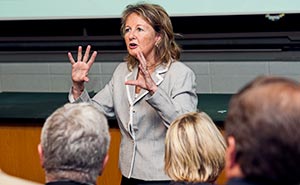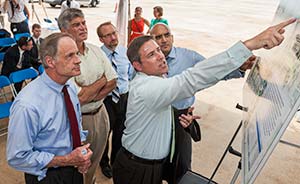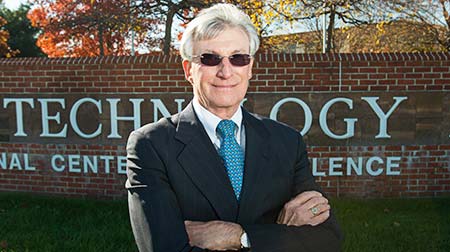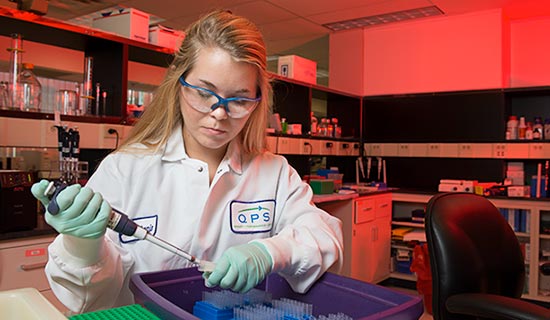



Across from the University of Delaware’s South Campus in Newark sits 272 acres which is getting a new lease on life. While once the Newark Chrysler Assembly Plant, this site is now known as UD’s Science, Technology and Advanced Research (STAR) Campus.
Since acquiring the site in November 2009, UD has made key investments and built strategic partnerships to ensure the STAR Campus is an investment in the future for innovation, research and academics alike.
Andy Lubin, UD director of real estate, explains that the University’s goal is to align itself with partners that “have the right combination of real estate, design, development, construction and financing expertise and experience.”
With that in mind, this past spring the University entered into a strategic partnership with Delle Donne and Associates Inc. and Bancroft Construction Company for phase one of the STAR Campus, which focuses on developing the existing former Chrysler administrative building along South College Avenue and high
bay space, positioned on approximately
15 acres of land. Construction began this past summer, and by the end of 2013,
this space will be remodeled and expanded from 170,000 square feet to 300,000 square feet and will house tenants from the health and life sciences.

“Our vision is to create an innovative campus where you can live, work and be healthy,” says Kathleen Matt, dean of the UD College of Health Sciences and executive director of the Delaware Health Sciences Alliance. Matt’s vision for STAR includes commercial organizations that foster health care start-ups and attract entrepreneurs and innovators, as well as build a strong health care workforce, which begins with her college.
Tenants will include both internal and external entities, among them the University’s College of Health Sciences, Department of Physical Therapy, Nurse Managed Health Center, Delaware Rehabilitation Institute, BADER Consortium, Delaware Health Sciences Alliance, clinics and laboratories, biomedical and biotechnology companies, and fitness facilities, as well as health care incubators, start-ups and nonprofits.
“These tenants hit a broad spectrum of all different types of health components and how they all work together with health and wellness,” Matt says.
While the initial focus is on health sciences, the University is building all aspects of its “3+1” strategy, which includes health and life sciences, energy and the environment, and national security and defense, as well as enabling transportation infrastructure.
“We’re building strategic partnerships that will provide research and innovation opportunities at the STAR Campus for faculty, students and the community,” says Scott Douglass, UD’s executive vice president and treasurer.

To leverage the benefits of the innovative community being created at the STAR Campus, some current UD operations and research projects are being relocated there—including UD’s fuel cell buses, which will be strategically located near Bloom Energy’s fuel cell manufacturing facility.
David Weir, director of UD’s Office of Economic Innovation and Partnerships, says one such example of a partnership and the type of company UD wants on the site is eV2g, a joint venture with NRG to build electric cars. While still in its early stages, more than a dozen charging stations were installed on the site this fall, which is part of an experimental program relating to UD’s patented vehicle-to-grid technology.
Weir highlights other opportunities due to the University’s articulation agreements and the Cooperative Research and Development Agreement (CRADA) with the U.S. Army at Aberdeen Proving Ground. “We’d likely create a cyber security program with classified facilities to do work outside of the campus,” says Weir. “The University has strategic partnerships that impact economic development from research to health sciences to the Army, and it’s all part of what’s adding to the STAR Campus.”
However, infrastructure is necessary to partner with those organizations outside of the immediate area. According to Lubin, infrastructure—the “plus one” component of the University’s strategy for the STAR Campus—is essential, which is why Lubin says it was so critical that the U.S. Department of Transportation awarded a $10 million TIGER IV grant this past summer to the Newark Regional Transportation Center Station Improvement Project, which will be located on the STAR Campus.
“This TIGER IV grant for the new station serves as a catalyst for the University’s infrastructure development of the STAR Campus,” says Lubin. “All of a sudden, it puts us in the middle of a commuter rail scenario rather than at the end of one, which changes the dynamics of this substantially.”
The funds will expand the Newark Train Station into a multi-modal hub while improving the operations in the adjoining freight yard, but the University hopes the commuter rail will attract those who may be in Aberdeen or Philadelphia but want to take advantage of the academic research at UD’s campus.

While the STAR Campus is the largest-ever expansion of the Newark campus, it is far from being the first time the University has built strategic relationships for a research and innovation site.
Adjacent to the University along Wyoming Road is the Delaware Technology Park (DTP), which has started 80 companies—54 on site and the rest in the area.
“We would like to erect our sixth building because we are out of space,” says Mike Bowman, president and chairman of DTP.
Bowman and Lubin, who have been working together for more than 15 years, agree that DTP has been a small-scale model for the STAR Campus—showcasing how to build a focused and successful research and technology park where innovation thrives.
“When we first started the Delaware Technology Park, DuPont was our anchor,” Bowman says. “Bloom Energy and UD’s College of Health Sciences are the anchors for the STAR Campus.”
Drawing on DTP’s model and success is proving to be just what the University needs to usher in the next phase of tech companies and innovative advancements.
“What we bring from the Delaware Technology Park to the STAR Campus is the opportunity to deal with proof-of-concept companies and early stage companies,” Lubin says. “Some of those companies are in the Tech Park and some of those would want to be in the Tech Park, but there’s a shortage of space to occupy them.”
Bowman says that by allowing start-ups and UD spin-off companies to mature and become commercial ventures within the Tech Park as the accelerators, these companies can then be brought over to the STAR Campus to grow.
This model also fits with Matt’s plans for the College of Health Sciences. “As programs grow with outreach pieces for companies,” Matt says, “we’ve talked about having some programs incubate at the Delaware Technology Park and then when they are fully developed, bring them to the STAR Campus.”
But this also enables the growth of partnerships. “There is so much potential economic development due to our partnership with the Army at Aberdeen Proving Ground, in particular, so it is logical to place start-ups that come out of APG on the STAR Campus,” Bowman notes.
Bowman frequently talks about QPS Holdings LLC, which started at DTP in 1996 with three employees. Today, it boasts more than 800 employees across the globe but still maintains its headquarters in the Delaware Technology Park, with a workforce of more than 200 on-site, including almost 40 UD alumni.
Among those alumni are Benjamin Hsu, chief financial officer at QPS Holdings, who received his master’s and doctorate from UD in chemical engineering.
Hsu says that DTP was a prime location for QPS Holdings to get started because of its strategic placement along I-95 on the East Coast as well as its proximity to UD, a world-class research institution. “We’ve been able to do recruiting from UD,” Hsu says. “Students can come in as interns to understand the drug research and development that we’re doing for our sponsors, which gives them the opportunity to see what it means to be an employee at QPS Holdings.”
For graduate student Melanie Smith, being a translational medicine intern at QPS Holdings has actually turned into a post-graduation employment opportunity.
“As a student, the location helped with doing an internship while still being in school,” says Smith, who started at QPS Holdings in 2011. Smith says interning at a biotech company was a requirement for her master’s program, and the combination of UD programs and resources with the experience at QPS was perfect.
“This was a great opportunity for me because what I was doing at QPS would be directly related to what I do at UD,” Smith says.
It is successes from the Delaware Technology Park and opportunities like Melanie’s that the University hopes to capitalize on at the STAR Campus by creating research, internship and externship possibilities by bringing the right mix of innovative companies to the site.
“The principles don’t change,” Bowman says, “the opportunities just get bigger.”
